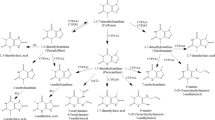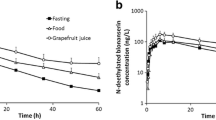Abstract
Objective
The oral availability of many drugs metabolised by the enzyme cytochrome P 450 3A4 (CYP3A4) is increased if co-administered with grapefruit juice. Extracts from grapefruit peel have also demonstrated inhibitory activity and, during commercial manufacturing of grapefruit juice, inhibitory components might be squeezed into the juice from the peel. Thus, the aim of this in vitro study was to identify CYP3A4 inhibitors in grapefruit peel.
Methods
Grapefruit peel was extracted with diethyl ether, and the extract was further fractionated by normal-phase chromatography. Fractions demonstrating significant CYP3A4 inhibitory activity, as measured by the relative reduction in N-demethylation of diltiazem in transfected human liver epithelial cells, were subsequently separated by preparative thin-layer chromatography. Constituents of the fractions and isolated compounds were identified by nuclear magnetic resonance spectroscopy. Analysis of diltiazem and N-demethyl-diltiazem was performed using high-performance liquid chromatography.
Results
Of the identified components in grapefruit peel, only epoxybergamottin demonstrated a concentration-dependent inhibition of the CYP3A4-mediated N-demethylation of diltiazem. The IC50 value was calculated to be 4.2±1.1 µM. Coumarins without the furan ring and flavonoids isolated from grapefruit peel did not interfere with the metabolism of diltiazem. The results indicated the presence of other CYP3A4 inhibitors in grapefruit peel, but these agents were lost during the purification process excluding their identification.
Conclusion
The furanocoumarin epoxybergamottin, present in grapefruit peel, is an inhibitor of CYP3A4. In commercial manufacturing of grapefruit juice, epoxybergamottin is possibly distributed into the juice. During manufacturing, however, epoxybergamottin may be hydrolysed to 6´,7´-dihydroxybergamottin, which has been suggested as an important CYP3A4 inhibitor in grapefruit juice.



Similar content being viewed by others
References
Josefsson M, Zackrisson AL, Ahlner J (1996) Effect of grapefruit juice on the pharmacokinetics of amlodipine in healthy volunteers. Eur J Clin Pharmacol 51:189–193
Bailey DG, Spence JD, Munoz C, Arnold JMO (1991) Interaction of citrus juices with felodipine and nifedipine. Lancet 337:268–269
Rashid TJ, Martin U, Clarke H, Waller DG, Renwick AG, George CF (1995) Factors affecting the absolute bioavailability of nifedipine. Br J Clin Pharmacol 40:51–58
Soons PA, Vogels B, Roosemalen MCM, Schoemaker HC, Uchida E, Edgar B, Lundahl J, Cohen AF, Breimer DD (1991) Grapefruit juice and cimetidine inhibit stereoselective metabolism of nitrendipine in humans. Clin Pharmacol Ther 50:394–403
Bailey DG, Arnold JMO, Strong HA, Munoz C, Spence JD (1993) Effect of grapefruit juice and naringin on nisoldipine pharmacokinetics. Clin Pharmacol Ther 54:589–594
Christensen H, Åsberg A, Holmboe A-B, Berg KJ (2002) Coadministration of grapefruit juice increases systemic exposure of diltiazem in healthy volunteers. Eur J Clin Pharmacol 58:515--520
Hukkinen SK, Varhe A, Olkkola KT, Neuvonen PJ (1995) Plasma-concentrations of triazolam are increased by concomitant ingestion of grapefruit juice. Clin Pharmacol Ther 58:127–131
Kupferschmidt HHT, Ha HR, Ziegler WH, Meier PJ, Krahenbuhl S (1995) Interaction between grapefruit juice and midazolam in humans. Clin Pharmacol Ther 58:20–28
Rau SE, Bend JR, Arnold JMO, Tran LT, Spence JD, Bailey DG (1997) Grapefruit juice terfenadine single-dose interaction: magnitude, mechanism, and relevance. Clin Pharmacol Ther 61:401–409
Clifford CP, Adams DA, Murray S, Taylor GW, Wilkins MR, Boobis AR, Davies DS (1997) The cardiac effects of terfenadine after inhibition of its metabolism by grapefruit juice. Eur J Clin Pharmacol 52:311–315
Kantola T, Kivisto KT, Neuvonen PJ (1998) Grapefruit juice greatly increases serum concentrations of lovastatin and lovastatin acid. Clin Pharmacol Ther 63:397–402
Lilja JJ, Kivisto KT, Neuvonen PJ (1998) Grapefruit juice–simvastatin interaction: effect on serum concentrations of simvastatin, simvastatin acid, and HMG-CoA reductase inhibitors. Clin Pharmacol Ther 64:477–483
Ducharme MP, Warbasse LH, Edwards DJ (1995) Disposition of intravenous and oral cyclosporine after administration with grapefruit juice. Clin Pharmacol Ther 57:485–491
Jetter A, Kinzig-Schippers M, Walchner-Bonjean M, Hering U, Bulitta J, Schreiner P, Sorgel F, Fuhr U (2002) Effects of grapefruit juice on the pharmacokinetics of sildenafil. Clin Pharmacol Ther 71:21–29
Wang EJ, Casciano CN, Clement RP, Johnson WW (2001) Inhibition of P-glycoprotein transport function by grapefruit juice psoralen. Pharm Res 18:432–438
Scora RW, Kumamoto J, Soost RK, Nauer EM (1982) Contribution to the origin of the grapefruit, Citrus paradisi (Rutaceae). Syst Biol 7:170–177
Guo LQ, Fukuda K, Ohta T, Yamazoe Y (2000) Role of furanocoumarin derivatives on grapefruit juice-mediated inhibition of human CYP3A activity. Drug Metab Dispos 28:766–771
Malhotra S, Bailey DG, Paine MF, Watkins PB (2001) Seville orange juice–felodipine interaction: comparison with dilute grapefruit juice and involvement of furocoumarins. Clin Pharmacol Ther 69:14–23
Kawaii S, Tomono Y, Katase E, Ogawa K, Yano M (1999) Quantitation of flavonoid constituents in Citrus fruits. J Agric Food Chem 47:3565–3571
Bailey DG, Arnold JMO, Munoz C, Spence JD (1993) Grapefruit juice felodipine interaction—mechanism, predictability, and effect of naringin. Clin Pharmacol Ther 53:637–642
Bailey DG, Dresser GR, Kreeft JH, Munoz C, Freeman DJ, Bend JR (2000) Grapefruit–felodipine interaction: effect of unprocessed fruit and probable active ingredients. Clin Pharmacol Ther 68:468–477
Fukuda K, Guo LQ, Ohashi N, Yoshikawa M, Yamazoe Y (2000) Amounts and variation in grapefruit juice of the main components causing grapefruit–drug interaction. J Chromatogr B 741:195–203
Edwards DJ, Bernier SM (1996) Naringin and naringenin are not the primary CYP3A inhibitors in grapefruit juice. Life Sci 59:1025–1030
Edwards DJ, Fitzsimmons ME, Schuetz EG, Yasuda K, Ducharme MP, Warbasse LH, Woster PM, Schuetz JD, Watkins P (1999) 6',7'-Dihydroxybergamottin in grapefruit juice and Seville orange juice: effects on cyclosporine disposition, enterocyte CYP3A4, and P-glycoprotein. Clin Pharmacol Ther 65:237–244
Ohnishi A, Matsuo H, Yamada S, Takanaga H, Morimoto S, Shoyama Y, Ohtani H, Sawada Y (2000) Effect of furanocoumarin derivatives in grapefruit juice on the uptake of vinblastine by Caco-2 cells and on the activity of cytochrome P450 3A4. Br J Pharmacol 130:1369–1377
Tassaneeyakul W, Guo LQ, Fukuda K, Ohta T, Yamazoe Y (2000) Inhibition selectivity of grapefruit juice components on human cytochromes P450. Arch Biochem Biophys 378:356–363
Schmiedlin-Ren P, Edwards DJ, Fitzsimmons ME, He K, Lown KS, Woster PM, Rahman A, Thummel KE, Fisher JM, Hollenberg PF, Watkins PB (1997) Mechanisms of enhanced oral availability of CYP3A4 substrates by grapefruit constituents—decreased enterocyte CYP3A4 concentration and mechanism-based inactivation by furanocoumarins. Drug Metab Dispos 25:1228–1233
Malterud KE, Rydland KM (2000) Inhibitors of 15-lipoxygenase from orange peel. J Agric Food Chem 48:5576–5580
Pfeifer AMA, Cole KE, Smoot DT, Weston A, Groopman JD, Shields PG, Vignaud JM, Juillerat M, Lipsky MM, Trump BF, Lechner JF, Harris CC (1993) Simian virus-40 large tumor antigen-immortalized normal human liver epithelial-cells express hepatocyte characteristics and metabolize chemical carcinogens. Proc Natl Acad Sci U S A 90:5123–5127
Macé K, Aguilar F, Wang JS, Vautravers P, Gomez-Lechon M, Gonzalez FJ, Groopman J, Harris CC, Pfeifer AMA (1997) Aflatoxin B-1-induced DNA adduct formation and p53 mutations in CYP450-expressing human liver cell lines. Carcinogenesis 18:1291–1297
Molden E, Åsberg A, Christensen H (2000) CYP2D6 is involved in O-demethylation of diltiazem—an in vitro study with transfected human liver cells. Eur J Clin Pharmacol 56:575–579
Christensen H, Carlson E, Åsberg A, Schram L, Berg KJ (1999) A simple and sensitive high-performance liquid chromatography assay of diltiazem and main metabolites in renal transplanted patients. Clin Chim Acta 283:63–75
Chen IS, Lin YC, Tsai IL, Teng CM, Ko FN, Ishikawa T, Ishii H (1995) Coumarins and antiplatelet aggregation constituents from Zanthoxylum schinifolium. Phytochemistry 39:1091–1097
Yamada Y, Nakatani N, Fuwa H (1987) Epoxyaurapten and marmin from juice oil in hassaku (Citrus hassaku) and the spasmolytic activity of 7-geranyloxycoumarin-related compounds. Agric Biol Chem 51:1105–1110
Tatum JH, Berry RE (1979) Coumarins and psoralens in grapefruit peel oil. Phytochemistry 18:500–502
Imai F, Itoh K, Kishibuchi N, Kinoshita T, Sankawa U (1989) Constituents of the root bark of Murraya paniculata collected in Indonesia. Chem Pharm Bull 37:119–123
Kinoshita T, Wu JB, Ho FC (1996) Prenylcoumarins from Murraya paniculata var omphalocarpa (Rutaceae): the absolute configuration of sibiricin, mexoticin and omphamurin. Chem Pharm Bull 44:1208–1211
Dugo P, Mondello L, Dugo L, Stancanelli R, Dugo G (2000) LC-MS for the identification of oxygen heterocyclic compounds in citrus essential oils. J Pharm Biomed Anal 24:147–154
Guo LQ, Taniguchi M, Xiao YQ, Baba K, Ohta T, Yamazoe Y (2000) Inhibitory effect of natural furanocoumarins on human microsomal cytochrome P450 3A activity. Jpn J Pharmacol 82:122–129
Author information
Authors and Affiliations
Corresponding author
Rights and permissions
About this article
Cite this article
Wangensteen, H., Molden, E., Christensen, H. et al. Identification of epoxybergamottin as a CYP3A4 inhibitor in grapefruit peel. Eur J Clin Pharmacol 58, 663–668 (2003). https://doi.org/10.1007/s00228-002-0537-3
Received:
Accepted:
Published:
Issue Date:
DOI: https://doi.org/10.1007/s00228-002-0537-3




